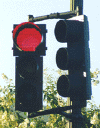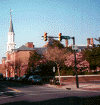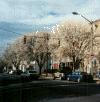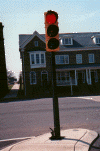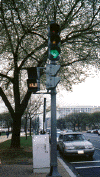Please click on the picture for a closer view!
![]()
ALABAMA- Alabama installations use mono-tube arms with yellow 12" signal heads hanging from span wire mountings. This enables them to move in high winds and keep pressure off of the attachment. This example is located in Mobile. (Photo by Alex Nitzman)
CONNECTICUT- Unusual signals abound in the Northeast and this signal is no exception! To save on signal heads, this signal displays the red for through movements and the green arrow for protected right turns! Pretty fascinating...and confusing for out-of-towners! (Photo by Paul DaSilva)
DELAWARE- Here is a simple diagonal span wire installation that is typically used in Delaware's older installations. Note how two directions of traffic are served by the one wire span. Unfortunately, this type of installation can present problems for the motorist to be able to see the signal when stopped on the approach that has the steeper signal viewing angle. Usually this can be reduced by setting the limit line further upstream of the intersection.
Here is a newer installation with the signals in both directions mounted on a single mast arm. This is used mostly on "T" intersections where the side road terminates into the main artery. The left turn pocket signals are mounted on their own mast arm. (Photos by Alex Nitzman)
FLORIDA- This is an example of Florida's "span wire" signals. The typical installation is heavy steel wire strung between tall concrete "strain" poles located on each corner. This is a less expensive installation than a mast arm type, but is subject to more maintenance and weather problems.
Another example
of the Florida installation. This is known as a "box
span" installation, as the signals "form a box"
around the intersection. As with many other states, Florida
doesn't use back plates around the signal heads. Both of these
pictures are located on Atlantic Ave. in Fernandia Beach, which
is on Amelia Island about 30 miles northeast of Jacksonville.
(Photos by Mark Furqueron)
GEORGIA- Generally, Georgia's signal installations are of the "box type" variety which use their own vertical strain poles. This example however makes use of existing utility poles, both metal and wood, as the strain poles to suspend the span wire! This is a very good example of a "custom" installation! (Photo by Dee Taylor)
MARYLAND- Maryland uses similar installation techniques for most mast arm and span wire mounting as other states. Their signals are usually painted yellow and they use 12" signal sections almost exclusively. This picture also shows the "Doghouse style" 5 light protective/permissive signal. (Photo by Tony Lenzi)
Here is a view of a double mast arm span.(Photo by Michael Mason)
This fire signal is a bit unusual because of the 8" flashing amber section that flashes when everything is "normal". When the signal is activated, it proceeds to the yellow clearance and red stop intervals just like a standard signal.(Photo by Tony Lenzi)
MASSACHUSETTS- Signal arrangements in this state are somewhat similar to other states, with the notable exception of the two-way signals connected together, hanging from a single point on the wire shown here. This makes replacement a little more tricky, but saves on the hang points! (Photo by Paul DaSilva)
MICHIGAN- This signal (on U.S. 2 in Ironwood) is a typical Michigan signal installation: Cable hung diagonally over the intersection, with two assemblies of lights each pointing in four directions. Variations seen include a third light assembly in the middle where the "left turn" sign is here. This third assembly has an illuminated "LEFT" sign on the top but has "ball" indications rather than arrow lights controlling left turn traffic. The left turn signals most always have the illuminated [LEFT] sign above them, as do any "protected" directions -- [RIGHT] is common. Less common is [THRU], which is normally used in conjunction with a single green arrow signal head which is always on, at an intersection where only one lane (i.e. the [LEFT] is controlled. Also, very common in Michigan is the "flashing red left turn light". At intersections where a "protective/permissive" left turn signal is not used, and it is safe to do so, a standard three head is used. During the "protective" phase, the green arrow is illuminated. During the "permissive" phase, the red ball flashes. This is treated like a standard red flasher for the left lane only, where one must stop and proceed if safe. This is generally used at most intersections, except for those with exceptionally fast oncoming traffic, unsafe/blind visibility intersections, or signals controlling a double lane left turn. Less common, but not rarely seen is another auxiliary light assembly (but with 8-inch rather than the standard 12-inch lenses) on the support pole on the far right corner. (Photo by Steve Riner, and additional information by Bill Cahill)
MISSISSIPPI- Here is an example of a signal installation in Mississippi. They are span wire mounted and frequently use the protected/permissive method for left turn traffic. This example is at Hwy 493 and North Hills St. in Meridian. (Photo by Adam Froehlig)
NEW JERSEY- New Jersey uses truss type mast arms in most of their installations.
Another view of New Jersey's truss arm signals, located in Atlantic City. Also of note is the frequent use of double truss masts on a single pole. (Photos by Alex Nitzman)
NEW YORK- Here is an example of what was once common in all mid sized towns across the nation. This 4 way is mounted on a pole and sits on a huge concrete foundation in the middle of the intersection. This is so "errant vehicles" wouldn't damage the signal. This one is located in Canajoharie, N.Y. (Photo by Frank Solomon)
And here is a hanging version of the 4-way located in Poughkeepsie, NY. Note the unusual mounting to a vertical pipe, rather that direct to the span wire. (Photo by Alex Nitzman)
SOUTH CAROLINA- Most of South Carolina's signals are similar to Florida's in installation methods...with a few notable exceptions, like the one pictured above. This one is located in Charleston and has been retrofitted onto an old lamp post. South Carolina has also has just fully converted to LED units in the red signals. Here in this view, we see the matrix of tiny LED's that make up the red "ball" signal. (Photos by Paul Stanford)
Another view of South Carolina signals. This shows a more typical installation with the 5 light doghouse signal for protective/ permissive movements.
TENNESSEE- Span wire installations are common here with this example being in Memphis. Tennessee uses a lot of 12" signals along with 12" and 8" combo signals together on the span. This intersection is at Elvis Presley Blvd. and Brooks Rd. (Photo by Christopher Knight)
VERMONT- This is an unusually short mast arm installation in Vermont for the narrower streets. Many times the side mounted signal in these installations will be mounted higher for increased visibility around parked larger vehicles or high foliage.
Here is an older installation in Vermont. Note that they use external terminal boxes (the small boxes located at the top of the signal on the wire) to connect the individual signals to the system. (Photos by Alex Nitzman)
VIRGINIA- The two examples of a Virginia signal shown here are located in the same city...Alexandria. It shows both the newer mast arm and the older span wire installations.
Another view of a pole mounted Virginia signal. Virginia likes to use yellow signals with cutaway or cap visors. (Photos by John Rietveld)
WASHINGTON, D.C.- This is a view of a typical DC signal. They are usually painted dark green or blue-grey and use the 12" heads. Also note the ornate pole and fancy pinnacle at the top of the signal. (Photo by John Rietveld)
All Contents Copyright 1997-2001 by John Rietveld


















